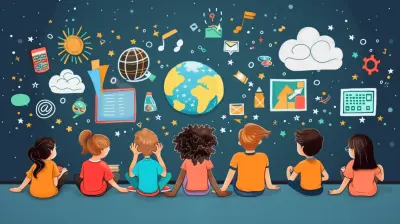The Benefits of Collaborative Learning in STEM Education
11 October 2025
Ah, collaborative learning. The phrase alone might make some students groan in agony, picturing themselves stuck in a group project where one person does all the work while the others contribute moral support. But before you roll your eyes and click away, let’s talk about why collaborative learning in STEM education isn't just a fancy buzzword professors throw around to sound progressive—it's actually beneficial (yes, really).

Why Work Together When You Can Suffer Alone?
Sure, you could go at it solo, locking yourself in a room with a pile of textbooks and enough caffeine to power a small city. But STEM (Science, Technology, Engineering, and Mathematics) isn't just about knowing facts—it's about solving real-world problems. And guess what? The real world doesn’t function in isolation. Scientists, engineers, and tech geniuses rarely work alone; they brainstorm, test ideas, fail spectacularly, and then try again—together.So why should students be any different?

The Magic of Collaborative Learning
What does collaborative learning bring to the table that solo studying doesn’t? Well, a lot. Let’s dive into the actual benefits before you assume it’s just another excuse to force students into awkward group discussions.1. It Teaches You How to Human (a.k.a. Communication Skills)
Believe it or not, knowing how to explain an idea without confusing or offending people is an actual skill—one that employers kind of love.STEM fields aren’t just about crunching numbers and running experiments; they require teamwork, brainstorming, and (gasp) actually talking to other people. Collaborative learning forces students to articulate complex ideas, listen to different perspectives, and decode the occasional cryptic explanation from that one teammate who speaks solely in technical jargon.
2. Problem-Solving: The Group Edition
If you've ever tried debugging a piece of code at 2 AM, you know that sometimes, your brain just refuses to cooperate. Enter collaborative learning.When students tackle complex STEM problems together, they bring diverse perspectives to the table. Maybe you're great at theoretical concepts but struggle with application. Meanwhile, your teammate can break down real-world scenarios but couldn't memorize a formula if their life depended on it. Together, you balance each other out—and suddenly, that impossible problem has a surprisingly logical solution.
3. It Mimics Real-World STEM Careers
Here's some shocking news: real STEM professionals don’t sit silently in a corner working alone. They collaborate across teams, departments, and even continents. Engineers trade ideas, scientists publish research together, and tech developers debug code as a team.Collaborative learning gives students a taste of this reality, making them not just better learners but also better professionals. Because let’s face it—if you can’t function in a team, your career options might shrink faster than a marshmallow in a vacuum chamber.
4. Failure Becomes Less...Depressing
Let’s be real: failing alone can feel like the end of the world. But failing in a team? That’s just another Tuesday.STEM is full of trial and error, and collaborative learning teaches students to embrace failure as part of the process. When one idea flops, another teammate might have a different approach. Instead of hitting a dead-end, the group learns to pivot and find alternative solutions. It’s like having multiple brains working toward the same goal—which, let’s be honest, is much better than suffering in silence.
5. It Makes Learning Less Painful (Sometimes, Even Fun!)
Let’s not sugarcoat it—STEM subjects can be brutal. Some concepts feel like they were designed specifically to torment students. But tackling them with a group? That makes it a lot more bearable.Collaborative learning allows students to engage in discussions, share tips, and laugh at their collective struggles. It's like forming a survival alliance in an academic Hunger Games—stay together, and you might just make it out alive.
6. Exposure to Diverse Perspectives
Ever noticed how different brains work in different ways? One person sees numbers and immediately thinks of patterns, while another sees those same numbers and starts sweating profusely.When students collaborate, they get exposed to unique thought processes and problem-solving approaches. This doesn’t just help with understanding STEM subjects—it fosters creativity, innovation, and, most importantly, patience (because let's be honest, working with other people requires a LOT of that).
7. Better Retention and Understanding
Listening to a professor drone on for hours? Probably not the best way to remember anything. But explaining concepts to a peer? That actually works.Teaching others forces students to simplify and clarify concepts, which is basically tricking their brains into learning better. It's science. And if you don’t believe me, go explain quantum mechanics to your pet and see if you suddenly understand it better.

Challenges of Collaborative Learning (a.k.a. The Downside)
Okay, let’s be fair—not every group project is a dream come true. Sometimes, you end up with teammates who ghost you until the night before the deadline. Other times, there's that one person who thinks they’re the boss and insists their idea is superior (spoiler: it’s not).But here’s the thing—those challenges are part of the learning experience. Whether it's dealing with different working styles, resolving conflicts, or figuring out how to get everyone on the same page, these problems mimic real-world teamwork. Learning how to navigate them now will save you from meltdowns later.

How to Make Collaborative Learning Actually Work
Now that we’ve (hopefully) convinced you that group work isn’t the enemy, here are a few tips to make it actually effective:- Set Clear Roles – Nobody likes doing all the work while someone else gets a free ride. Assign tasks early on.
- Use Technology – Platforms like Google Docs, Slack, or Notion can help with communication and organization.
- Respect Different Perspectives – Just because someone thinks differently doesn’t mean they’re wrong (unless they’re suggesting dividing by zero).
- Stay Organized – Procrastination is a team sport, but trust me, last-minute disasters are not fun.
- Don’t Be Afraid to Speak Up – If something isn’t working, address it before it spirals into a full-blown academic catastrophe.
Final Thoughts
Like it or not, collaborative learning is here to stay—especially in STEM education. It mirrors real-world teamwork, boosts problem-solving skills, and makes studying slightly less painful. Sure, there will be frustrating moments, but that’s all part of the experience.So, the next time you’re assigned a group project, resist the urge to groan. Who knows? You might just learn something—and maybe even make some friends along the way.
all images in this post were generated using AI tools
Category:
Stem EducationAuthor:

Olivia Lewis
Discussion
rate this article
1 comments
Zaid Anderson
Collaborative learning in STEM not only fosters critical thinking but also cultivates essential teamwork skills for future innovators.
October 20, 2025 at 4:53 AM

Olivia Lewis
Thank you for your insightful comment! Indeed, collaborative learning in STEM is vital for developing both critical thinking and teamwork skills, which are essential for fostering future innovation.


